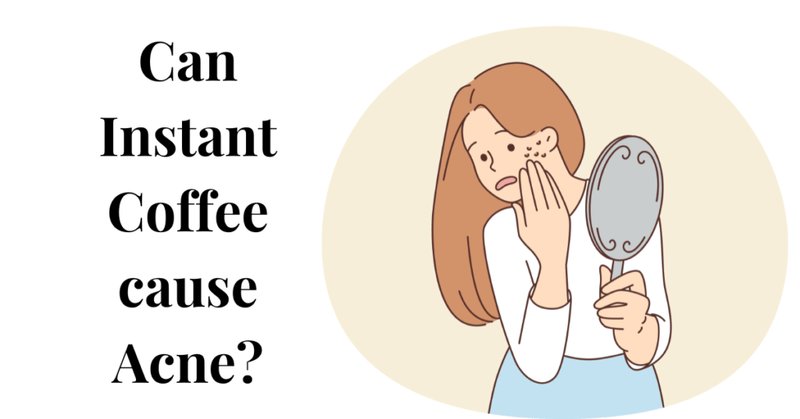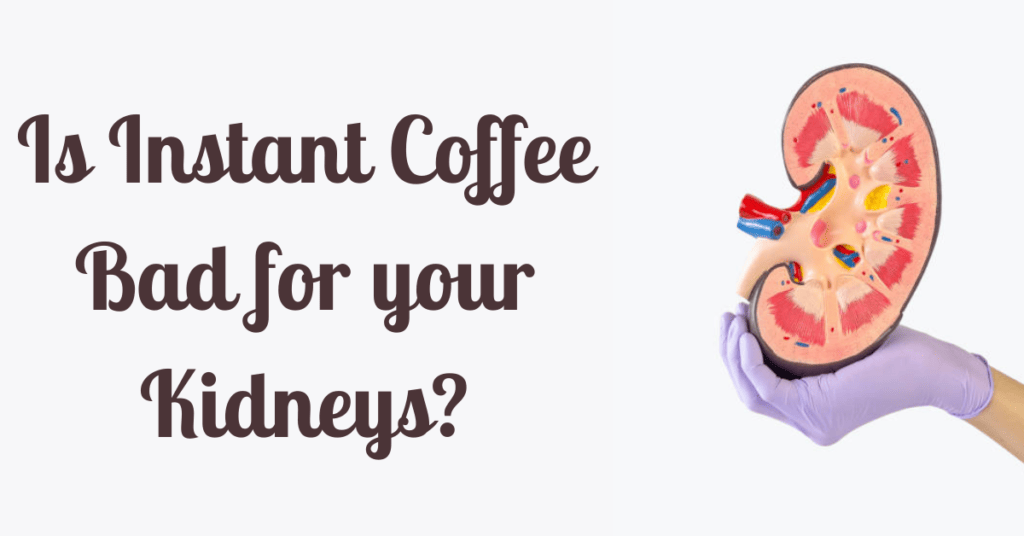The relationship between coffee consumption and skin health has long intrigued individuals seeking a clearer complexion. While studies on the direct correlation are limited, some evidence suggests that excessive caffeine intake may contribute to skin issues. . Let’s delve into the nuances of this intriguing question. Can Instant Coffee cause Acne?
Coffee provides an affordable beauty solution, particularly for achieving a tan without resorting to harsh chemicals. You can create a coffee tanning lotion, blend coffee grounds with olive oil, or boil used coffee grounds to achieve tan skin. Acne occurs when hair follicles, small openings in the skin, become blocked. Sebaceous glands, tiny glands near the skin’s surface, are connected to these follicles, which serve as the openings from which individual hairs grow.
Approximately 90% of adolescents, regardless of gender, experience acne, with the prime age range being 14-19 years old. Individuals with widespread moderate to severe acne often require additional intervention in the form of acne treatments.
Six Foods that may contribute to Acne: Individuals with acne often consume higher amounts of refined carbohydrates (4, 5).
- Dairy products.
- Fast food.
- Chocolate.
- Whey protein powder.
- Foods to which you are sensitive.
Consistent application of a coffee mask reduces marks and blemishes, leaving your skin smooth, bright, and blemish-free. Another notable benefit of Coffee is its ability to diminish pigmentation on lips. Create a mixture by combining half a tablespoon of coffee powder, half a tablespoon of honey, and the juice of half a lemon.
As an affiliate site, we are associated with the amazon. We might receive a commission when you use links or recommendations on our website to make qualified purchases. The cost you pay for the goods or services is unaffected by this.
Table of Contents
Can Instant Coffee cause Acne: Let’s Talk About Instant Coffee and Hormones

Let’s discuss the potential effects of instant coffee on three hormones: cortisol, estrogen, and insulin.Instant Coffee is derived from real coffee beans, wherein the soluble and volatile components are extracted. The resulting powder or concentrated soluble Coffee is obtained after removing water. Essentially dehydrated for convenience, you can simply add water to enjoy a quick brew!
Instant Coffee presents various health benefits, potentially boasting more antioxidants than other brews. It allows for easy customization of caffeine levels and flavor, offering a convenient and lower-waste option for daily coffee indulgence.
Similar to brewed Coffee, individuals sensitive to caffeine may encounter adverse effects like jitters, anxiety, or shakiness when consuming instant Coffee. According to various studies, the optimal daily consumption of instant Coffee is typically considered to be 3–5 cups, a range often associated with the highest risk reductions.
Additionally, opt for coarsely ground dark roasts when using a French press.
Create Coffee gelatin by dissolving instant coffee in hot water, blending it with gelatin, and refrigerating it.
Be cautious of acid reflux triggered by the high acidity in instant coffee.
Instant coffee is low in calories and doesn’t directly contribute to weight gain.
You can also make a frappe using instant coffee.
Enhance your smoothie with a coffee-flavoured twist by mixing in instant coffee.
Opt for sugar-free instant coffee for its low-calorie content and quick preparation.
1. Cortisol
- Cortisol is often called the “stress hormone” because its levels tend to increase in response to stress.
- Caffeine, present in instant coffee, can stimulate the release of cortisol. This is part of the body’s natural stress response.
- While moderate caffeine intake might not significantly impact, excessive caffeine consumption, including instant coffee, may contribute to elevated cortisol levels.
2. Estrogen
- Estrogen is a primary female sex hormone, but it is also present in males in smaller amounts.
- Some studies suggest that coffee consumption may influence estrogen levels, but the evidence is inconclusive.
- The impact of coffee on estrogen can vary based on factors like the individual’s sex, age, and overall health.
- The effects, if any, are likely modest and may not significantly impact hormonal balance in most individuals.
3. Insulin
- Insulin is a hormone that plays a crucial role in regulating blood sugar levels.
- Caffeine can affect insulin sensitivity, potentially leading to changes in blood sugar levels.
- Some studies suggest moderate caffeine intake may improve insulin sensitivity, but excessive consumption may lead to insulin resistance.
- When consumed in moderation, instant coffee is unlikely to have a detrimental effect on insulin levels for most individuals. However, those with existing insulin-related health issues should be cautious about caffeine intake.
In summary, while instant coffee, like any caffeinated beverage, can influence hormone levels to some extent, the key is moderation.
Sugar and Acne
The correlation between sugar and Acne has sparked interest in the quest for clearer skin. Scientific evidence suggests high sugar intake may exacerbate Acne, influencing inflammation and insulin resistance. Consuming sugary foods can elevate blood sugar levels, triggering an insulin response that, in turn, stimulates oil production and skin cell growth—common precursors to Acne.
Moreover, a diet high in refined sugars may contribute to systemic inflammation, intensifying skin issues. While individual responses vary, understanding the potential impact of sugar on Acne underscores the importance of a balanced diet and lifestyle choices for maintaining skin health.
Crafting a natural lip scrub using ingredients like Coffee and sugar is ideal for addressing dry, flaky lips, ensuring they remain nourished and soft. Incorporating a lip exfoliator into your routine can be beneficial for avid matte lipstick enthusiasts prone to dry, chapped lips.
Acne treatment

The primary prescription topical medications for treating acne include:
Topical Medications
- Retinoids and Retinoid-like Drugs: These drugs, containing retinoic acids or tretinoin, are effective for moderate acne. Examples are tretinoin (Avita, Retin-A), adapalene (Differin), and tazarotene (Tazorac). Application is typically in the evening, starting three times a week and gradually progressing to daily use. They prevent hair follicle plugging. Avoid simultaneous use of tretinoin with benzoyl peroxide.
- Antibiotics: These medications kill excess skin bacteria, reducing redness and inflammation. They are often used in combination with benzoyl peroxide to minimize antibiotic resistance. Examples include clindamycin with benzoyl peroxide (Benzaclin) and erythromycin with benzoyl peroxide (Benzamycin). Topical antibiotics alone are not recommended.
- Azelaic Acid and Salicylic Acid: Azelaic acid, a naturally occurring acid, has antibacterial properties. A 20% cream or gel is as effective as conventional treatments. Prescription azelaic acid (Azelex, Finacea) is safe during pregnancy. Salicylic acid helps prevent plugged hair follicles and is available in wash-off and leave-on products.
- Dapsone: Dapsone (Aczone) 5% gel, applied twice daily, is recommended for inflammatory acne, especially in women. Possible adverse reactions can involve experiencing redness and dryness. Nevertheless, limited evidence supports the efficacy of zinc, sulfur, nicotinamide, resorcinol, sulfacetamide sodium, or aluminum chloride in topical treatments for acne.
Oral Medications
- Antibiotics: Common choices include Tetracyclines (minocycline, doxycycline) or macrolides (erythromycin, azithromycin). Use oral antibiotics for the shortest time possible to prevent resistance and combine them with benzoyl peroxide.
- Combined Oral Contraceptives: FDA-approved for acne therapy in women, combining progestin and estrogen. Side effects include weight gain, breast tenderness, nausea, and increased risks of cardiovascular problems, breast cancer, and cervical cancer.
- Anti-Androgen Agents: Spironolactone (Aldactone) may be considered for women and adolescent girls if oral antibiotics are ineffective. Potential adverse effects may encompass breast tenderness and discomfort during menstrual periods.
- Isotretinoin: A vitamin A derivative prescribed for severe acne unresponsive to other treatments. Side effects include inflammatory bowel disease, depression, and severe birth defects. Regular monitoring is essential.
Therapies
Additional therapies that may be helpful include:
- Light Therapy: Various light-based therapies have shown some success, requiring multiple visits for optimal results.
- Chemical Peel: Repeated applications of chemical solutions, such as salicylic or glycolic acid, may improve mild acne. Results are temporary, requiring repeat treatments.
- Drainage and Extraction: Tools gently remove whiteheads, blackheads, or cysts that persist despite topical medications, temporarily improving skin appearance but potentially causing scarring.
- Steroid Injection: Nodular and cystic lesions can be treated with steroid injections for rapid improvement, though side effects may include skin thinning and discoloration in the treated area.
Skin Benefits of Coffee
Coffee offers many skin benefits, making it more than a morning pick-me-up. Packed with antioxidants, Coffee helps combat free radicals, reducing oxidative stress and contributing to a healthier complexion. The caffeine content in Coffee is known to improve blood circulation, reducing the appearance of dark circles and puffiness.
Its natural exfoliating properties promote cell turnover, leaving the skin refreshed and rejuvenated. When used in scrubs, coffee grounds can exfoliate dead skin cells, revealing a smoother texture. Additionally, Coffee’s anti-inflammatory properties may soothe irritated skin. Incorporating Coffee into skincare routines can provide a natural and invigorating boost for a radiant and revitalized complexion.
Is Tea instead of Coffee better?

The choice between tea and Coffee often boils down to personal preference, but each beverage offers distinct advantages. Tea, mainly green tea, boasts antioxidants supporting skin health, potentially reducing the risk of specific skin issues. Unlike Coffee, tea contains less caffeine, making it a gentler option for those sensitive to stimulants.
Additionally, tea’s hydrating properties contribute to overall skin hydration. However, Coffee’s higher caffeine content can provide a more robust energy boost. Ultimately, the “better” choice depends on individual preferences, tolerance to caffeine, and specific health goals. Both tea and Coffee can be part of a balanced and enjoyable approach to daily hydration.
How do I remove Acne?
Combatting Acne involves a multifaceted approach for effective results. Start with a gentle cleanser to remove excess oil and debris from the skin. Incorporate over-the-counter topical treatments containing benzoyl peroxide or salicylic acid to target acne-causing bacteria and promote exfoliation. Maintain a consistent skincare routine, avoiding harsh products that may irritate the skin.
Hydration is vital, so drink plenty of water to keep the skin well-hydrated.
A balanced diet rich in fruits and vegetables and low in processed foods can positively impact skin health. Avoid picking or squeezing Acne, as it may worsen inflammation and scarring. If over-the-counter remedies prove insufficient, consult a dermatologist for personalized recommendations, including prescription medications or professional treatments like chemical peels or laser therapy. Patience and consistency are crucial in managing and preventing acne breakouts.
Is Acne normal?
Acne, prevalent in adolescence, results from clogged hair follicles with oil and dead skin cells. Hormonal changes, genetics, and lifestyle influence its development.
While it is most prevalent during puberty, Acne can persist into adulthood for some individuals. It’s important to note that having Acne does not reflect poor hygiene or cleanliness. Effective management often involves a combination of proper skincare, a balanced diet, and, in some cases, medical interventions. A dermatologist can provide personalized guidance and treatment options for persistent or severe Acne.
What is inside a Pimple?

A pimple, a papule or pustule, contains a mixture of substances that accumulate within the hair follicle and surrounding skin. The primary components inside a pimple include:
- Sebum: An oily, waxy substance produced by the sebaceous glands in the skin. Excess sebum production can contribute to the formation of pimples.
- Dead Skin Cells: As the skin sheds its outer layer, dead skin cells can accumulate and mix with sebum, creating a plug that blocks the hair follicle.
- Skin naturally hosts bacteria like Propionibacterium acnes. Blockages in hair follicles allow bacterial multiplication, causing inflammation and infection.
- White Blood Cells: In response to bacterial invasion, the body sends white blood cells to the affected area to combat the infection. This immune response contributes to the redness and swelling associated with pimples.
The combination of these elements results in the characteristic appearance of a pimple. If the inflammation is more profound, it may form nodules or cysts, which can be more severe and potentially leave scars. Proper skincare and treatment can help manage and prevent the formation of pimples.
Why do Pimples Bleed?
Pimples may bleed when the wall of the hair follicle or pore, where the pimple forms, becomes damaged or breaks. Several reasons can contribute to pimple bleeding:
- Inflammation: When a pimple becomes inflamed, the surrounding skin can be sensitive and easily damaged. Scratching or picking at the pimple can cause it to rupture, leading to bleeding.
- Forcible Extraction: Squeezing or popping a pimple forcefully can rupture the blood vessels in the surrounding skin, resulting in bleeding. This can also introduce bacteria from the hands into the open wound, potentially worsening the situation.
- Deep or Cystic Pimples: Pimples deeper in the skin or cystic in nature may extend into the surrounding tissues. When these pimples rupture, they can cause bleeding due to their deeper location.
It’s crucial to avoid picking or squeezing pimples to prevent damage, scarring, and further infection. Applying clean, gentle pressure with a sterile cotton pad or tissue can help stop bleeding. If pimples persist or are causing concern, consulting with a dermatologist for proper care and guidance is advisable.
Types of Acne
Acne manifests in various forms, each characterized by specific symptoms and appearances. Common types of AcneAcne include:
- Whiteheads: Closed comedones, appearing as small, white bumps on the skin’s surface caused by blocked hair follicles.
- Blackheads: Open comedones with a dark appearance due to the exposure of the blocked pore to air, resulting in oxidation.
- Papules: Small, red, inflamed bumps without a visible center. They may be tender to the touch and are caused by a deeper blockage in the hair follicle.
- Pustules: Similar to papules but containing pus at the center, giving them a white or yellowish appearance.
- Nodules: Large, painful, solid lumps beneath the skin caused by deep blockages. Nodules can be more severe and may lead to scarring.
- Cysts: Painful, pus-filled lesions that are deeper and larger than pustules. Cysts can cause significant inflammation and scarring.
Understanding the specific type of Acne is crucial for determining the appropriate treatment. Consulting with a dermatologist can help in identifying the acne type and developing an effective skincare regimen or medical intervention plan.
Causes of Acne
Acne is a complex skin issue influenced by multiple factors. Typical causes encompass:
- Excess Sebum Production: Overproduction of sebum, an oily substance, can clog hair follicles, leading to the development of Acne.
- Hormonal Changes: Fluctuations in hormones, especially during puberty, menstruation, pregnancy, and hormonal disorders, can contribute to increased sebum production and Acne.
- Bacterial Infection: Propionibacterium acnes, a naturally occurring skin bacterium, can multiply within blocked hair follicles, causing inflammation and Acne.
- Inflammation: Inflammatory responses triggered by stress, pollution, or certain foods can exacerbate Acne.
- Genetics: A family history of Acneacne can increase an individual’s susceptibility to developing the condition.
- Diet: While the link is not fully understood, some studies suggest that a diet high in processed foods and sugars may influence acne development.
- Cosmetic Products: Certain makeup or skincare products can clog pores, forming Acneacne.
- Medications: Some medications, such as corticosteroids or certain birth control pills, can influence hormonal balance and contribute to Acneacne
Understanding the specific causes of an individual’s Acnecnea is essential for effective management.
How severe can Acne get?
Acne severity can vary widely, ranging from mild and occasional breakouts to severe and persistent conditions. The extent of Acne is often categorized into several grades:
- Mild acne features whiteheads, blackheads, and minimal inflammation. Some papules or pustules may be present in this stage.
- Moderate Acne: More widespread presence of papules, pustules, and occasionally, nodules. Increased redness and inflammation may be observed.
- Severe Acne: Extensive lesions, including numerous nodules and cysts. Severe redness, inflammation, and potential scarring are common. This type of Acne often requires medical intervention.
- Acne Conglobata: A rare and severe acne characterized by interconnected nodules and abscesses. It can lead to severe scarring and may persist for an extended period.
- Acne Fulminans: A sporadic and severe form associated with systemic symptoms like fever and joint pain. Immediate medical attention is required.
Seeking the advice of a dermatologist is crucial for proper diagnosis and developing an effective treatment plan tailored to the individual’s specific condition. Early intervention can help prevent long-term scarring and improve overall skin health.
How do Antibiotics treat Acne?

Antibiotics are often prescribed to treat Acne, mainly when the condition is moderate to severe or when topical treatments prove insufficient. Here’s how antibiotics work in treating Acne:
- Anti-Inflammatory Properties: Antibiotics, such as tetracycline, doxycycline, or minocycline, possess anti-inflammatory properties. They help reduce the inflammation associated with acne lesions, such as papules, pustules, and nodules.
- Inhibition of Bacteria: Acne is partly caused by the proliferation of Propionibacterium acnes bacteria within clogged hair follicles. Antibiotics work by inhibiting the growth of these bacteria, thereby reducing the number of inflammatory lesions.
- Suppression of Immune Response: Antibiotics can modulate the immune response, preventing an exaggerated inflammatory reaction to the presence of bacteria in the hair follicles.
Can Instant Coffee cause Acne: FAQS
Is Instant Coffee good for Acne?
Coffee has potential benefits for the skin, scalp, and hair, aiding in exfoliation, acne treatment, improving blood flow, and maintaining pH balance.
Does Nescafe Coffee cause Acne?
Although Coffee doesn’t cause acne, certain studies propose it might exacerbate existing conditions.
Can Milk cause Acne?
According to some studies, cow’s milk, including whole, low-fat, and skim, is associated with an increased likelihood of acne breakouts despite its low glycemic index.
Is Coffee good for OILY skin?
While Coffee might be effective, various factors influence its impact on your skin. Consider taking a skin quiz to identify the best ingredients for your skin and tailor your skincare routine accordingly.
Bottom Line
In conclusion, the relationship between instant coffee consumption and acne is complex and multifaceted. While some studies suggest a potential link between specific components in coffee and skin issues, it is crucial to approach this information with caution. Factors such as individual skin sensitivity, overall diet, and lifestyle choices can significantly influence the development of acne.
Indulging in a daily cup of Coffee can support healthy hair growth; however, it’s essential to be mindful, as excessive consumption may lead to hair loss. Too much caffeine can impede the hair growth cycle, slowing down the regrowth process and potentially causing a delay in hair recovery.
The combination of honey and Coffee offers remarkable benefits for your skin. Coffee grounds contribute to exfoliation, enhancing texture, and caffeine helps diminish puffiness. Honey, valued for its antibacterial and moisturizing properties, promotes beautiful skin when used consistently.







